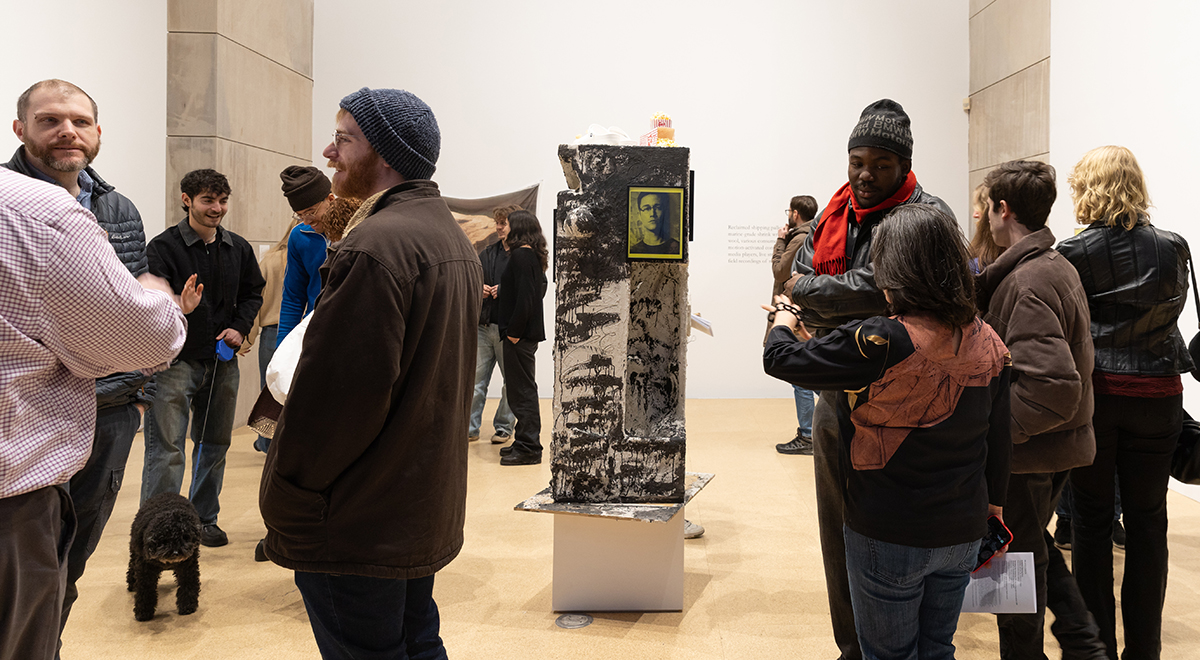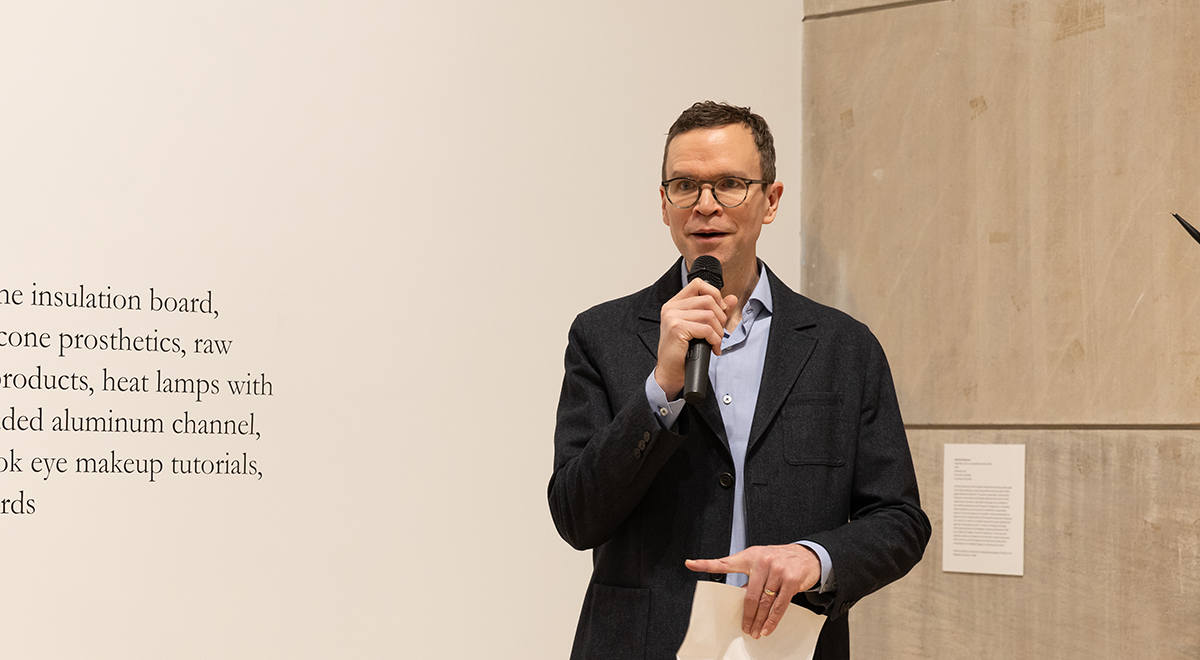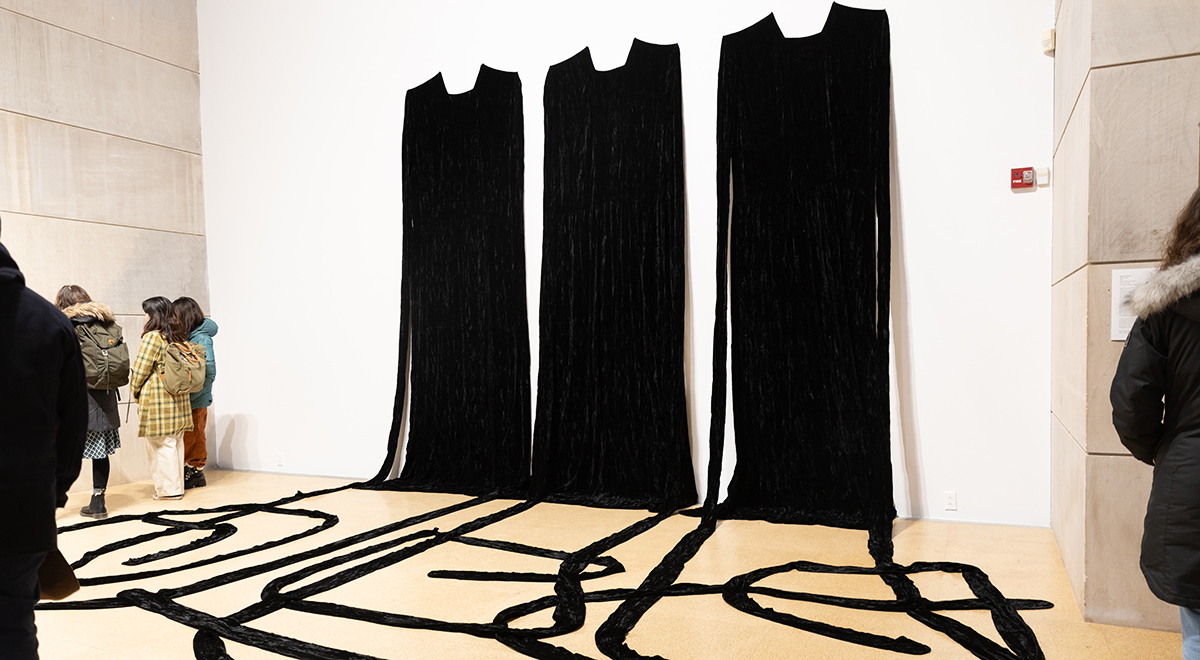CFA Exhibit Celebrates 50 Years of History

The 50th-anniversary exhibition in the Ezra and Cecile Zilkha Gallery, “Always Being Relation: 50 Years of the Gallery at the CFA”, which will feature the works of more than 30 artists, will be on display at the Center for the Arts (CFA) from January 30 through March 3.
With this exhibition, Associate Director of Visual Arts Benjamin Chaffee ’00, and Exhibitions Manager Rosemary Lennox have pushed the boundaries of the usual “alumni” show format, putting in dialogue work by artists who studied at Wesleyan University with artists who have exhibited their work in the gallery since its opening in the fall of 1973.
“We’re hoping to show the amazing variety and quality of work that has come through Wesleyan, and also how important and vital the gallery has been to generations of artists,” Chaffee said.

Dedicated to presenting groundbreaking solo and group exhibitions and installations that explore contemporary issues, often through an interdisciplinary lens, as well as site specific projects that take advantage of the unique and majestic space, the gallery had presented “The Alumni Show” curated by Nina Felshin in 2003, and “The Alumni Show II” curated by John Ravenal ’81, P’15 in 2013, for previous Center for the Arts decennial anniversary seasons.
Chaffee and Lennox started thinking about this new exhibition more than three years ago and began working with students to research the gallery’s archives.
“Always Being Relation: 50 Years of the Gallery at the CFA” will include new works by Ariadne Fish, Salim Green ’20, Rachel Harrison ’89, Glenn Ligon ’82, Hon. ’12, Melissa Marks ’87, P ’23, Cameron Rowland ’11, and virgil b/g taylor ’15.
Art Preparator Paul Theriault built three walls in the gallery to allow Chaffee and Lennox to arrange the art based on conceptual connections between artist practices, as opposed to aesthetic relationships in their resulting works.
Chaffee said he tends to work intuitively, and often thinks in terms of responding to or engaging with the architecture or structural design in the gallery. And, Lennox noted that the history of the gallery is not so linear, and that it is interesting to think about the connections between artists that have happened across time. “I think it really opens up the idea of time in the gallery,” she said.
Chaffee said he likes to encourage visitors to carry ideas as they travel through the gallery and develop their own meaning and relationships across the works in the exhibition. “What motivates an artist, or how does an artist make decisions about artistic practice?” he asked.
One of the sculptural works in the show by Kahlil Robert Irving is on loan from the collection of Ligon, which was originally displayed in the gallery during Irving’s first solo exhibition in New England in 2018, “Street Matter — Decay & Forever / Golden Age.” And in turn, Irving is loaning a 1994 sculpture from his collection by Beverly Semmes to be shown in “Always Being Relation.”
The exhibition also includes works by alumni who weren’t part of the Art Studio program as undergraduates, including Dana Hoey ’89 who majored in Philosophy, Andrew Witkin ’00 who was a double major in American Studies and Art History, and Salim Green who studied Sociology at Wesleyan. “We’re highlighting how the gallery may have impacted their experience or decisions to go on into a creative field, or feel excited about being around art,” Lennox said.
Recent student interns who helped with the exhibition by uncovering some of the rich ephemera in the gallery’s archive include Gabrielle Farina ’23, Archie Caride ‘23, Madeleine Levinsohn ’23, and Emmett Levy ’24. Farina and Caride found a postcard with instructions on how to install Sol LeWitt’s wall drawing in the group show “Large Drawings” in 1984, which the gallery has since made into a t-shirt.

As part of their jobs starting in the fall of 2023, Levinsohn and Levy helped to write the wall labels for the exhibition, articulating the intention, context, history, and meaning of the artworks. Their research included conversations with artists, with Levinsohn speaking with Witkin and Hoey; while Levy spoke with Marks, Salim Green, and virgil b/g taylor. “The artists were so generous with their time,” Levy said. “This internship has been a magical experience for me.” He plans to pursue a similar position after he graduates in May.
New York-based artist Melissa Marks ’87, P ’23 is Caride’s mother, and remembers walking by the South Gallery when LeWitt’s wall drawing was being installed in 1984, and wondering about the fundamental question of where the artist is in that process. Another exhibition that made an impression on Marks was a show of Cindy Sherman’s film stills in the gallery in 1983. “I remember being agitated and challenged. … I just kept coming back, trying to crack what it was that I was looking at,” Marks said of Sherman’s exhibition. Both LeWitt and Sherman will also have works in the 50th-anniversary exhibition.
Marks is creating the new, site-specific, pencil and acrylic wall drawing “Before Volitia” for “Always Being Relation.” The installation includes two colored pencil works on paper and painting directly on the wall. Marks is exploring foundational ideas she started thinking about as an undergraduate at Wesleyan while studying painting with Jacqueline Gourevitch.
“That’s fun, all the bubbling up of my own prequels. Everyone loves a good origin story,” Marks said, before returning to draw on the twelve-foot square gallery wall, which she later follows with her painting. Marks’ work is located in the same gallery bay where her son Caride had his Senior Thesis Exhibition on display in 2023. “I’ve got new ideas that are bubbling up because of his work also,” Marks said of her son’s sculptures.
“I don’t really know what the painting is going to look like,” Marks said of her improvisational style of working and rehearsing with her own invented vocabulary. “I’m experimenting on the wall in the moment…all the decisions are there for you to see.”
Works in the exhibition that were previously on display at Wesleyan include a 1978 sculpture by German artist Franz Erhard Walther that he had shown in the gallery during his first solo institutional show in the United States in 1988; and a sculpture by Fred Sandback (1943 – 2003) which is being installed by Witkin in the same location that he had helped Sandback install the work during Sandback’s solo show in 1999, when Witkin was a student working in the gallery. Witkin will be installing his own work for “Always Being Relation,” in addition to the works by Sherman via his Boston-based Krakow Witkin Gallery.
“I am most excited to see the pieces exist in the same space, like a reunion of sorts, and find new resonances in one another,” said Levinsohn, who is starting a position as an American Art Curatorial Intern at the Brooklyn Museum later this month.
Related events next month include the screening of a film by the Karrabing Film Collective and a conversation with founding member of the collective Elizabeth A. Povinelli and Assistant Professor of Anthropology George Bajalia on February 7; and a conversation between Carrie Yamaoka ‘79 and Claire Grace, Associate Professor of Art History and American Studies, and Program Director of Art History in the Department of Art and Art History, on February 27.

